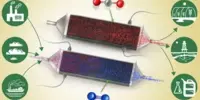The blue economy refers to the sustainable use and management of ocean resources, including fisheries, aquaculture, shipping, energy, tourism, and other marine-related industries. The outlook for the blue economy is promising, but there are also significant challenges to address.
On the positive side, the world’s oceans and coasts are vast resources that have the potential to support economic growth and development, while also providing vital ecosystem services such as carbon sequestration, climate regulation, and biodiversity conservation. The global ocean economy is already valued at over $1.5 trillion annually, and is expected to continue growing.
A handful of highly productive fisheries feed a billion people and employ tens of millions. These fisheries are found on the eastern equator, off the West Coast of the United States, the Canary Islands, Peru, Chile, and Benguela. There, a process known as upwelling brings cold water and nutrients to the surface, supporting large numbers of larger sea creatures on which humans rely for food.
A new project led by Texas A&M University researchers seeks to understand how climate and ocean changes will affect fisheries in the United States and around the world.
“We’re interested in how climate change will affect upwelling and the sustainability of future fisheries,” said Ping Chang, the Louis and Elizabeth Scherck Chair in Oceanography at Texas A&M University (TAMU). “It turns out that increasing the resolution of our climate models brings the upwelling simulation much closer to reality.”
We’re interested in how climate change will affect upwelling and the sustainability of future fisheries. It turns out that increasing the resolution of our climate models brings the upwelling simulation much closer to reality.
Ping Chang
The project, which is funded by the National Science Foundation (NSF), aims to develop medium to long-term fishery forecasts based on some of the highest-resolution coupled climate forecasts ever run. It is one of 16 Convergence Accelerator Phase 1 projects addressing the ‘Blue Economy,’ or the responsible use of ocean resources for economic growth. Convergence projects bring together researchers from various scientific disciplines.
The TAMU team, led by oceanographer Piers Chapman, includes computational climate modelers, marine biogeochemical modelers, fishery modelers, decision support system experts, and risk communications scholars from academia, federal agencies, and industry.
The climate modeling component of the research is led by Chang and Gokhan Danabasoglu of the National Center for Atmospheric Research (NCAR). They power their research with the Frontera supercomputer at the Texas Advanced Computing Center (TACC), the fastest academic supercomputer in the United States.
Andrew Bakun, a marine biologist, proposed in the 1990s that a warming climate would increase upwelling in the eastern boundary regions. He reasoned that because the land is warming faster than the oceans, the temperature gradient between the two would drive a stronger wind, increasing upwelling. However, recent historical data suggests that the inverse may be the norm.

“A lot of papers written in the past use coarse resolution models that don’t resolve to upwell very well,” Chang said. “High-resolution models so far predict upwelling in most areas, not increasing. The models are predicting warmer, not colder temperatures in these waters. In Chile and Peru, the warming is quite significant 2-3ºC warming in the worst case scenario, which is business as usual. That can be bad news for upwelling.”
Upwelling occurs in narrow and localized areas, but it has a significant impact on the marine ecosystem. For example, the eastern Pacific upwelling is only about 100 kilometers wide. The climate models used by the Intergovernmental Panel on Climate Change (IPCC) have a resolution of 100 kilometers, producing only one data point for the upwelling region, not nearly enough to accurately predict future changes.
Chang and his colleagues’ model, on the other hand, has a resolution of 10 kilometers in each direction. These are 100 times more detailed than the IPCC models and necessitate roughly 100 times the computational power.
Chang’s research is based on two distinct but related sets of simulations. The first set consists of a high-resolution coupled Earth system model ensemble (the same model run with a slightly different starting point to produce a statistically valid result). The second uses observed data from the atmosphere to generate realistic ocean states, which are then used to kick-start the model prediction. Beginning in 1982, it will conduct five-year retrospective forecasts to assess the model’s ability to forecast upwelling effects.
“There’s a limit to how far ahead you can forecast,” Chang explained. “The model loses skill after a certain period of time. Our model is still useful after five years.”
In January 2023, the team published their findings in Nature’s Communications Earth & Environment. The Blue Economy project is part of a multi-decade effort by the TAMU-NCAR team to improve global climate models’ resolution and physical accuracy. The team’s model was one of a few high-resolution Earth system models included in the most recent IPCC report and is currently being investigated by an IPCC subcommittee. They are the face of global climate modeling in the future.
At 10-kilometer resolution, researchers believe it is possible for models to realistically generate extreme weather events like tropical cyclones or atmospheric rivers, as well as more refined predictions of how climate in a specific region will change. However, models at this resolution still cannot resolve clouds, which requires models with a few kilometer resolutions and can currently only be integrated for short-term, not climate, timescales.
The effort to capture the Earth system is progressing. The TAMU-NCAR project will be among the first to incorporate biogeochemical ocean models and fisheries models into Earth system models with a resolution of 10 km.
“TACC is unique in that it provides resources for researchers like us to address fundamental scientific questions,” Chang said. “Routine forecasts are not our goal. What we seek is a better understanding of the Earth system dynamics that are missing from current climate models in order to improve our model and methods. I’m not sure we could do simulations like we do without Frontera. It’s crucial.”
















